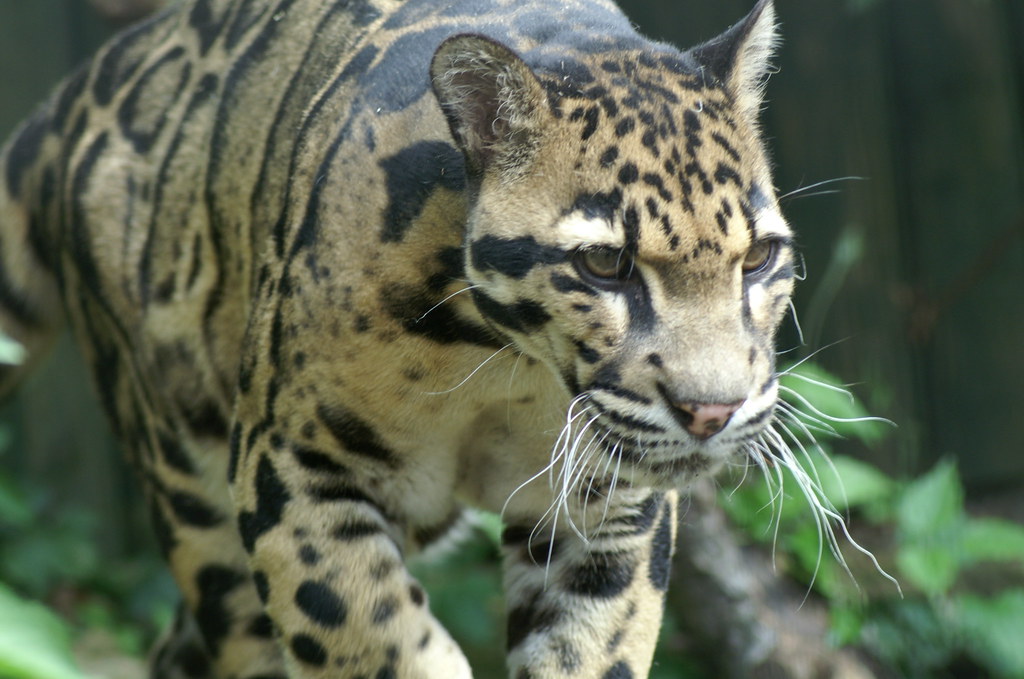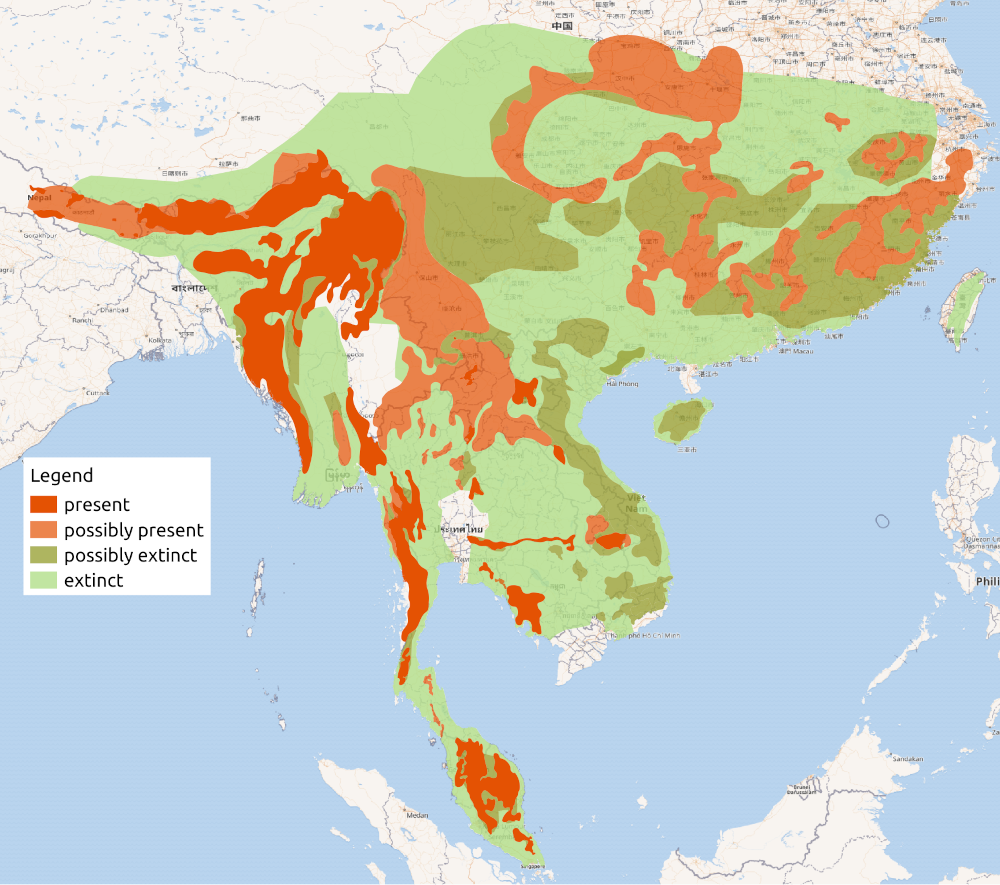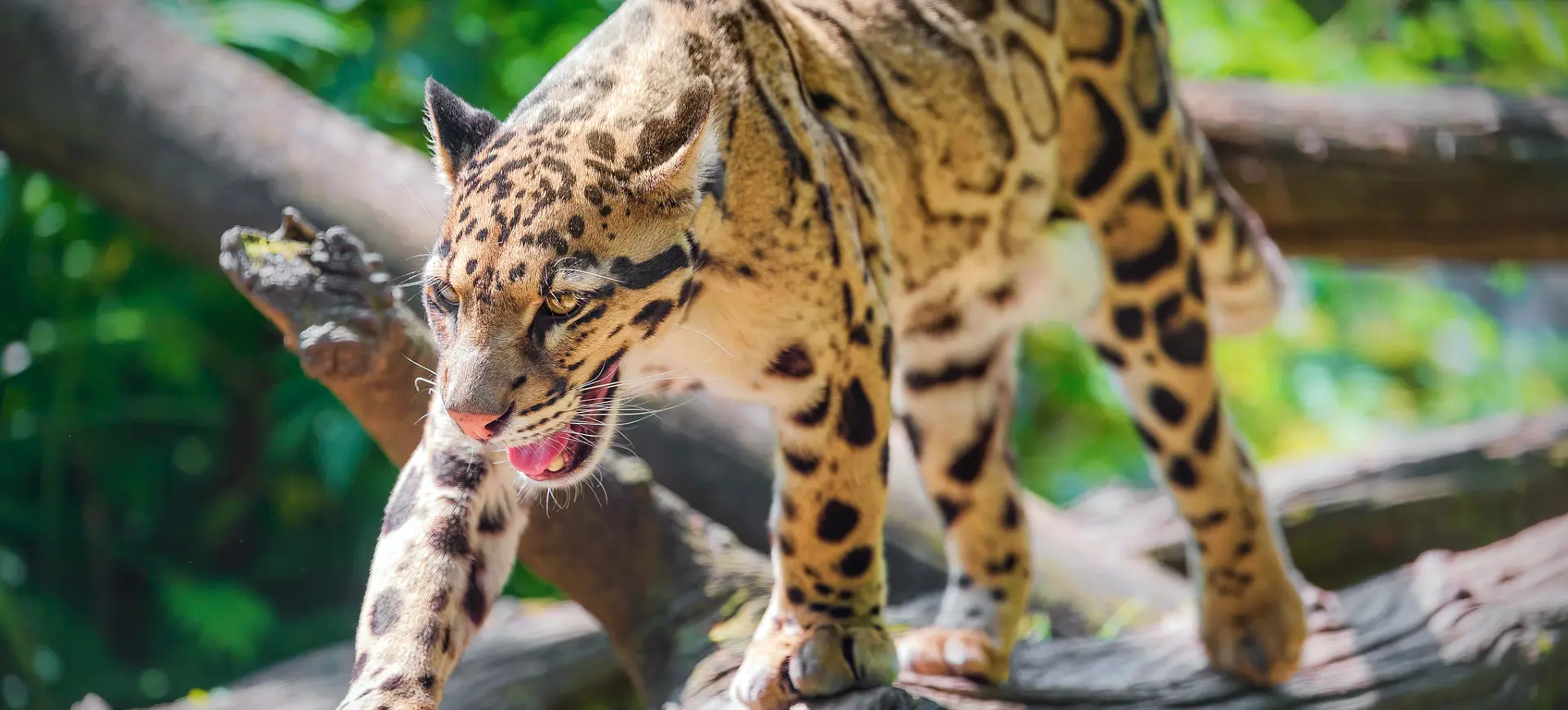Navigating the high canopies of Southeast Asia’s tropical forests, the clouded leopard is an arboreal master with a striking coat and physical prowess that commands respect. This article explores these fascinating felines, from their biology and behavior to the conservation efforts underpinning their survival, offering a comprehensive view into an animal’s life critical to its ecosystem.
Learn more by reading our ultimate profile of the Clouded Leopard
Key Takeaways
- Clouded leopards are specially adapted to arboreal life with anatomical features like large paws, flexible ankles, and impressive canine teeth, but they primarily hunt on the ground.
- They display sexual dimorphism, with males significantly heavier than females, influencing their solitary lifestyle and behaviors within their habitat.
- Conservation efforts, especially captive breeding programs, face challenges due to stress and habitat requirements. However, successful conservation initiatives like the Thailand Clouded Leopard Consortium show promise for the species’ future.
Distinctive Features of the Clouded Leopard
With their lithe bodies and adept climbing skills, clouded leopards command the treetops with an agility that leaves onlookers in awe. These felines are not just ordinary cats; they are a marvel of evolution, perfectly adapted to a life spent among the branches and leaves. On International Clouded Leopard Day, we celebrate these incredible animals and their distinctive features that set them apart from the other members of the feline family.
From its anatomical adaptations to its signature coat patterns and impressive dentition, the clouded leopard’s every aspect is a testament to its unique place in the animal kingdom.
Anatomical Adaptations for Arboreal Life
Clouded leopards are the epitome of arboreal adaptation, their bodies crafted by nature for unparalleled agility in the trees. Their large, dexterous paws, with specialized footpads and sharp, retractable claws, allow them to grip branches easily, making them adept climbers. The flexible ankle joints, capable of turning hind feet backward to descend headfirst or hang upside down, are feats of acrobatic prowess that few other animals can match.
This combination of large paws and flexible ankles is crucial to their survival, enabling them to navigate the complex arboreal terrain safely.
The Signature Coat Pattern
 One cannot discuss the clouded leopard without marveling at its stunning coat pattern. The ‘cloud-shaped’ dark blotches that adorn their tawny gray fur are not just visually striking; they are a masterclass in natural camouflage. These patterns blend seamlessly into the dappled light of the forest canopy, rendering the clouded leopard nearly invisible to both prey and predators alike.
One cannot discuss the clouded leopard without marveling at its stunning coat pattern. The ‘cloud-shaped’ dark blotches that adorn their tawny gray fur are not just visually striking; they are a masterclass in natural camouflage. These patterns blend seamlessly into the dappled light of the forest canopy, rendering the clouded leopard nearly invisible to both prey and predators alike.
This signature coat allows the clouded leopard, a silent hunter shrouded in mystery, to thrive in the forest’s shadows, skillfully using its tail for balance.
The Impressive Dentition
The clouded leopard’s dentition stands out as a remarkable feature in wild cats. With canine teeth that are proportionally the longest of any feline, they are an evolutionary marvel. These formidable canines, sometimes exceeding two inches in length, are essential tools for their predatory lifestyle.
Unsurprisingly, the clouded leopard’s impressive dentition has become a point of fascination for researchers and wildlife enthusiasts, often prompting logs and more comments in scientific journals highlighting their unparalleled bite.
The Stature of the Species: Body Size and Weight
In the realm of the clouded leopard, size does matter. A closer look at the stature of these felines reveals a noticeable variation between the sexes, with males generally tipping the scales as the larger sex. This difference in body size and weight is intriguing and plays a crucial role in their solitary and secretive lifestyle, influencing everything from hunting strategies to social interactions.
Males: The Larger Counterparts
When it comes to clouded leopards:
- Males are the undisputed heavyweights, weighing up to 50 pounds.
- These larger counterparts dominate in size, sometimes even doubling the weight of their female peers.
- The size advantage of male clouded leopards, which ranges from 24 to 50 pounds, is a matter of physical prowess and an attribute that potentially influences their role within their habitat.
Their robust stature allows them to patrol larger territories and compete more effectively for resources, ensuring they can continue their survival.
Females: Comparatively Petite
In contrast to their male counterparts, female clouded leopards are the more timid members of the species. With a weight range between 25 to 35 pounds, these females are noticeably smaller in stature. This size difference is not merely a matter of physical appearance but has implications for their behavior and ecology.
Smaller body size may afford female clouded leopards certain advantages, such as greater agility and stealth, essential attributes for a solitary hunter in the dense forests they call home.
Habitats High and Low: Where Clouded Leopards Thrive
The clouded leopard, a master of adaptation, has claimed a wide range of habitats as its home. From the dizzying altitudes of the Himalayan foothills to the dense mangrove swamps of Borneo, these felines demonstrate a remarkable ability to thrive in diverse environments.
On International Clouded Leopard Day in March, we reflect on the high and low territories these magnificent creatures inhabit, marveling at their versatility and resilience in the face of ever-changing landscapes.
Geographic Distribution
 The geographic tapestry of the clouded leopard’s range is as varied as the ecosystems it encompasses. Southeast Asia serves as the backdrop for this feline’s existence, with its presence felt across a swath of nations, from the foothills of Nepal to the rainforests of Borneo.
The geographic tapestry of the clouded leopard’s range is as varied as the ecosystems it encompasses. Southeast Asia serves as the backdrop for this feline’s existence, with its presence felt across a swath of nations, from the foothills of Nepal to the rainforests of Borneo.
The clouded leopard navigates an expanse that stretches over diverse habitats, including southern China and the historically populated Taiwan, making it a true wanderer of the Asian forests.
Habitat Preferences
The clouded leopard’s habitat preferences include:
- Lowland tropical rainforests, which provide the primary backdrop for their secretive lives, offering ample coverage and abundant prey
- Dry woodlands
- Secondary forests
These adaptable felines are remarkably able to adapt to various forest types, including those with abundant log presence.
Even beyond the forests, clouded leopards utilize grasslands and scrub areas, with the mangrove swamps of Borneo standing out as a testament to their habitat versatility.
Behavioral Traits: Communication and Sleep Patterns
The clouded leopard’s behavior is as intriguing as its appearance, marked by unique vocalizations and a nocturnal lifestyle that sets it apart from many of its feline kin. These solitary creatures, shrouded in the darkness of the night, communicate and interact in ways that reflect their elusive nature.
As we unravel the mysteries of their behavior, let’s venture into the world of these masters of the night and listen for the subtle whispers of their presence.
Vocalizing Their Presence
While clouded leopards may not roar like their larger cousins or purr like the smaller domesticated felines, they have a vocal repertoire all their own. Growl hisses and chuffing are the primary sounds these cats emit, serving as their distinctive means of communication in the dense forests they inhabit. These vocalizations, alongside various other sound communications not fully documented, are essential for clouded leopards to express themselves, whether for mating, territory or simply making their presence known to others of their kind.
Masters of the Night
As night falls, the clouded leopard emerges from the shadows to engage in the rituals of its nocturnal existence. This preference for the cover of darkness allows them to move unseen, hunt effectively, and maintain the solitary lifestyle that defines them.
The darkness provides a cloak for their hunting endeavors and a time for rest and rejuvenation, ensuring they remain the enigmatic phantoms of the forest.
Dietary Regimen: What Clouded Leopards Eat
The diet of the clouded leopard is as strictly carnivorous as it gets, with a preference for a variety of prey that sustains its existence in the wild. Their diet is meticulously managed in captivity to ensure they receive the necessary nutrients for optimal health.
This section will delve into the hunting prowess of these cats in their natural environment and the care taken to maintain their dietary regimen in human care.
In the Wild: Natural Predators
In the wild, the clouded leopard is a formidable predator. It employs stealth tactics to ambush unsuspecting prey from the trees or stalk them on the ground. Despite their arboreal skills, these cats are primarily ground hunters, using the forest floor as their main stalking terrain.
Their diet is rich and varied, including birds, squirrels, monkeys, and wild pigs, showcasing their adaptability as hunters in different environments.
In Human Care: Ensuring Nutritional Balance
A balanced diet is key to clouded leopards’ well-being in human care. Zoos and conservation facilities provide controlled diets that may include a variety of meats and specialized feeds, all tailored to meet the nutritional needs of these felines. At institutions like the Smithsonian’s National Zoo, clouded leopards enjoy a diet that includes Natural Balance and ground beef fortified with essential nutrients like calcium and taurine.
Additionally, dietary enrichment such as beef knuckle bones and papaya frozen in ice blocks promotes dental health. It provides behavioral stimulation, ensuring these captive cats maintain a level of physical and mental activity akin to their wild counterparts.
Challenges in Reproduction: The Struggle for Continuity
Reproduction among clouded leopards presents complex challenges that conservationists and wildlife experts strive to overcome. From mate compatibility issues to breeding complications, the struggle for continuity within the species is a pressing concern.
The following sections will discuss these challenges in detail and highlight the conservation efforts to secure the future of these enigmatic cats.
Breeding Complications
Breeding clouded leopards in captivity is a delicate process, often hindered by high-stress levels that can impede successful mating. Factors such as confined spaces, insufficient hiding areas, and constant exposure to zoo visitors and nearby predators contribute to these stress levels, making reproduction challenging for these sensitive animals.
Conservation Efforts
Despite the breeding challenges, conservation efforts have seen significant strides, particularly through initiatives like the Thailand Clouded Leopard Consortium. This collaborative effort has been pivotal in establishing a self-sustaining captive population, with over 55 cubs born between 2002 and 2015.
Such success stories are a beacon of hope, demonstrating that with improved keeper training and dedicated care, the future of clouded leopards can be bright.
Summary
From the treetops of Asia to the enclosures of conservation facilities, the clouded leopard’s journey is resilient and adaptable. We have explored its distinctive features, unraveled the mysteries of its behavior, and confronted the challenges it faces in a rapidly changing world. As we continue to learn and advocate for these elusive felines, their story reminds us of our responsibility to protect the intricate tapestry of life on our planet.
Frequently Asked Questions
What physical adaptations help clouded leopards climb so effectively?
Clouded leopards can climb effectively due to their large, dexterous paws with specialized footpads, retractable claws, and flexible ankle joints that allow them to navigate trees with ease. These physical adaptations are crucial for their arboreal lifestyle.
How does the coat pattern of a clouded leopard aid in its survival?
The clouded leopard’s coat pattern aids in its survival by providing effective camouflage in the forest canopy. This allows it to stealthily approach prey and remain hidden from potential threats. This unique pattern features ‘cloud-shaped’ dark blotches on a tawny gray background.
What are the primary vocalizations of clouded leopards?
Clouded leopards primarily communicate using growling, hissing, and chuffing. These vocalizations are essential for social interactions, territory establishment, and mating behaviors.
What challenges do clouded leopards face in terms of reproduction?
Clouded leopards face challenges in reproduction due to mate compatibility issues and high-stress levels in captivity, which can lead to aggressive behaviors and impede successful breeding efforts. It’s important to address these factors to support the reproduction of clouded leopards.
What initiatives are in place to conserve clouded leopards?
Efforts like the Thailand Clouded Leopard Consortium focus on enhancing captive breeding programs and keeper training to establish a self-sustaining population of clouded leopards. These initiatives contribute to the overall conservation of the species.


